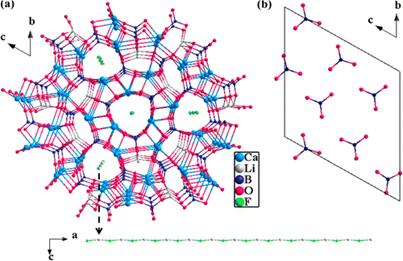A New Salt-Inclusion Borate Synthesized
Editor: | Jun 06,2013
In recent years, ultraviolet (UV) coherent light has attracted wide attention in microelectronics fabrication, optical data storage, and laser medicine, etc., because it has prominent properties, such as high photon energy, high spatial resolution, and small heat-affected zone. The best way to produce the UV coherent light with solid-state lasers is to rely on the process of second-harmonic generation (SHG) using nonlinear optical (NLO) materials.
Researchers from Xinjiang Technical Institute of Physics & Chemistry, Chinese Academy of Sciences (XTIPC), synthesized a new salt-inclusion borate, Li3Ca9(BO3)7·2[LiF]. Researchers use the coplanar configuration of the BO3 triangles in the crystal lattices and choose the alkali metal and alkaline-earth metal cations, which have no d–d electron transitions and are ideal for the transmission of UV light. Besides, in order to widen the transparency range, the F– anion is also introduced. Then a new UV NLO material, [Li3Ca9(BO3)7]·2[LiF] (LCBF), was synthesized. It possesses a moderate SHG response, a wide transparency range, and relatively large birefringence. Researchers found it contains a channel along the a axis, where the Li–F chain resides (Fig.1). So it can be regarded as a LiF salt-inclusion borate. The salt-inclusion solids are common in the compounds containing transition metal oxide (MOn, n = 4–6) and oxyanion (M′O4m–, M′ = Si, P, As, Ge) units, in which the salt lattice plays an essential role in bulk structural and chemical/physical properties. However, there are relatively few salt-inclusion solids reported in borates.
Based on the experimental results, LCBF shows a wide transparent region with a UV cutoff edge at about 230 nm. The moderate SHG response and large birefringence, as well as the wide transparent region, will be favorable for the practical applications of LCBF as a UV NLO material.
The result has been published on Inorg. Chem., 2013, 52 (9), 5359–5365.

Fig.1 (a) The one-dimensional open-framework structure filled with the Li–F chain (Li–O bonds omitted for clarity). (b) The coplanar arrangement of BO3 triangles in the unit cell. (Image by XTIPC)
附件下载:
 (86) 991-3838931
(86) 991-3838931 lhskj@ms.xjb.ac.cn
lhskj@ms.xjb.ac.cn (86)991-3838957
(86)991-3838957 40-1 Beijing Road
Urumqi, XinjiangChina
40-1 Beijing Road
Urumqi, XinjiangChina